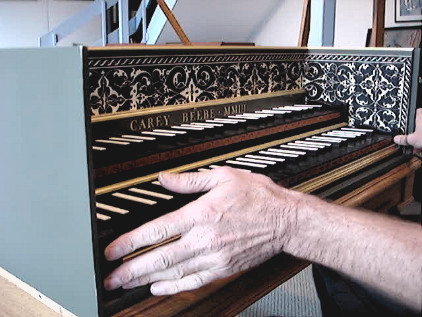Technical Library
KEYBOARDS III: Quick transposition method
Entire Contents Copyright © 2012 CBH |
  |

CAREY BEEBE |
| Hand position for quick transposition |
The quick transposition method…
Here is the quick method, which works on many good instruments with a little
practice. It’s not for the fainthearted, and be wary that some instruments
(especially those with jack bottom screws) may be inclined
to jam no matter how fluent the transposition is seemingly accomplished.
 |
THE FAST TRANSPOSING METHOD IS NOT SUITABLE FOR ALL INSTRUMENTS:
RELY ON THE OPINION OF YOUR MAKER OR TECHNICIAN. |
If
you want to try the fast method to transpose from A415 to A440, just follow these simple steps. Once you have investigated the exact needs of your instrument and get
used to the necessary manoeuvre, you will be playing in the transposed pitch in less than one minute:
- Check to see if there are any keyboard holddown screws you must remove. (Not
all instruments use these.) Most holddown screws are accessed from the bottom of the harpsichord,
although for some other instruments you must actually go hunting for the screws by lifting a few keys around
the top or bottom notes.
- Some instruments do not have a housing cut in the side of the keyframe to
clear the jacks for the bottom note in a transposed position. If this is the
case, you may have to lift the jacks for the bottom note, or even remove them entirely and keep them in a
safe place.
- Turn all choirs on to help the jacks hang from their dampers.
- Pull out the right hand transposing piece. Some instruments
might require you to remove the nameboard batten to enable you to access the transposing
piece.
- In a smooth but firm and instantaneous motion, push on the lower manual keyend blocks to slide
the keyboards to the right until they stop against the cheek. If you have a
double manual instrument, the upper manual usually sits on the frame of the lower and will
move with it. Do not push the upper manual keyend blocks, because they do not
always have the opportunity of as firm an attachment as the lower. Some instruments
have access to the middle of the keyframe through a hole cut in the front bottom: If your harpsichord
has this, engage your finger or tip of the tuning hammer in the housing cut in the underside of the balance rail to move your keyboard.
- Slip the loose transposing piece into the now vacant space at the left.
- Replace the keyboard holddown screws and the nameboard batten if you had to remove
these parts.
- Sometimes the 4´ jacks—especially in the treble where there may
be no dampers—may want to drop between the keys if there is any hesitancy
in the transposition process, and jam them. Check by playing all the notes. If
necessary, just briefly lift the offending jacks if they happen to have caught on the
key end cloth, and be sure to reinstall the jackrail properly.
To return to the original A415 pitch, follow a similar procedure to move the transposing piece now at the left back to its original position at the right.
|
 |
 |
Transposition
Carey Beebe demonstrating how to transpose the keyboard
from A392 to A415 to A440. |
 |
 |
 |
Transposition II
Carey Beebe demonstrating how to transpose a double-keyboard harpsichord
from A392 to A415 to A440 and back again. |
 |
|
